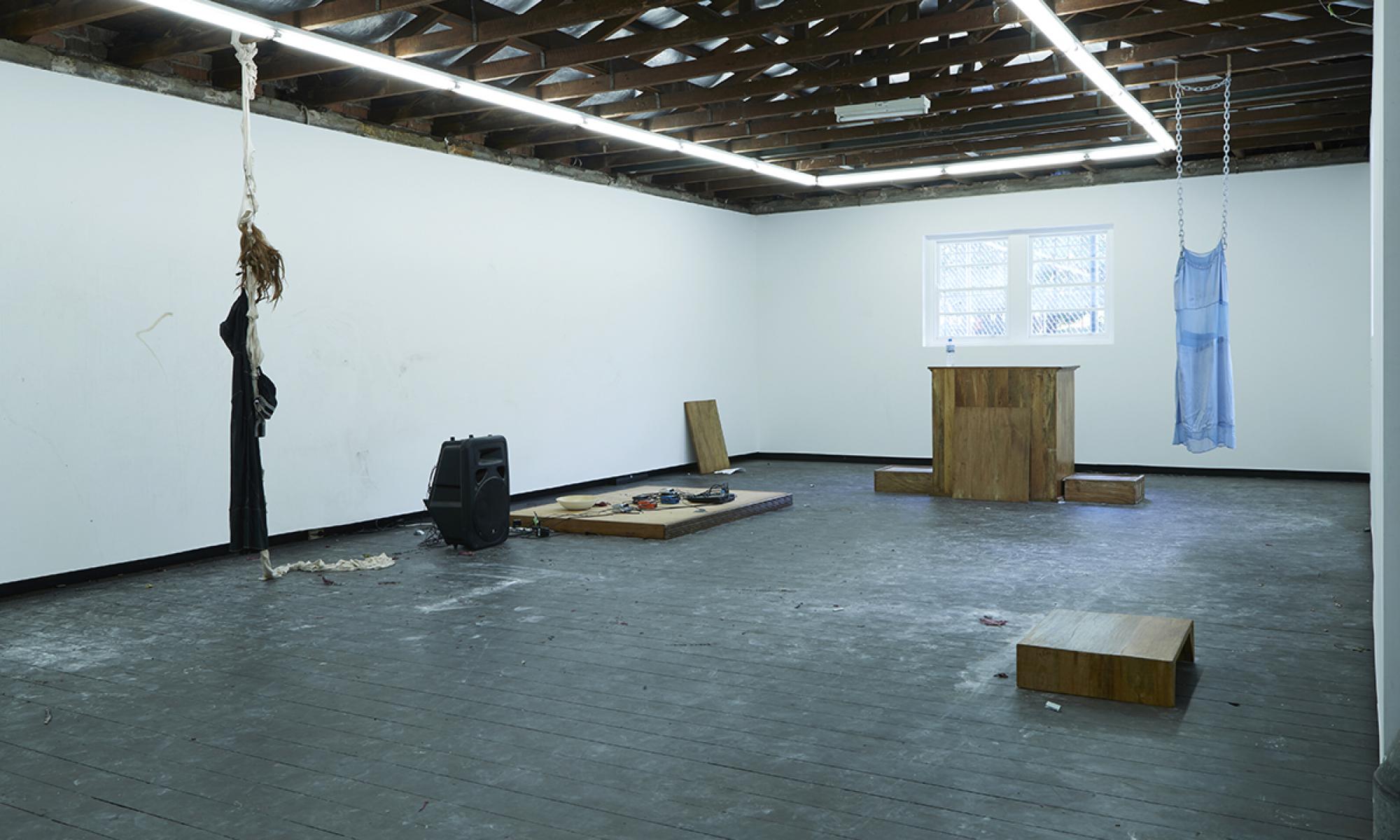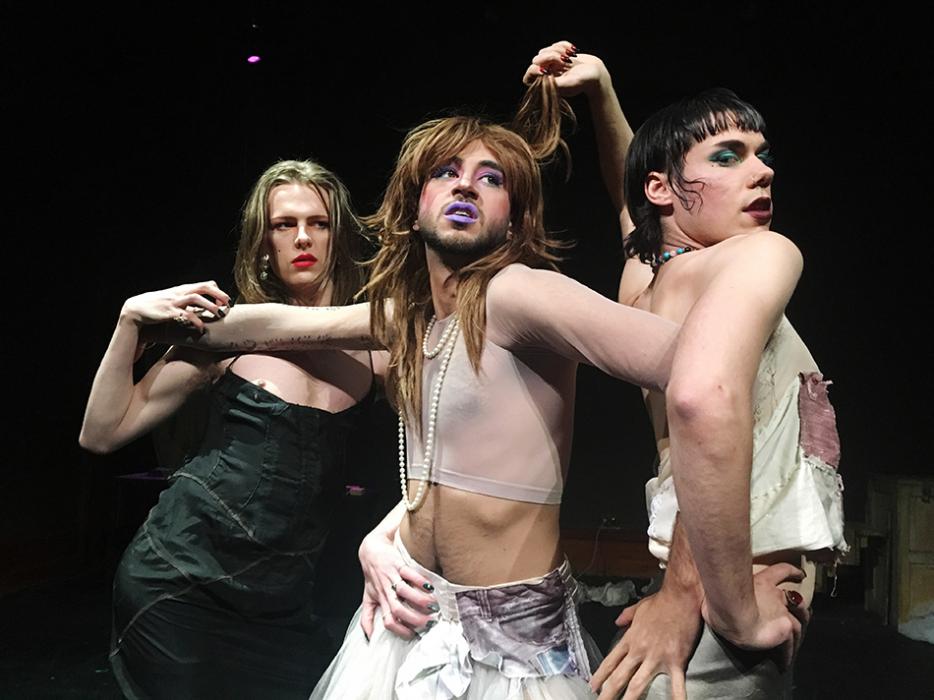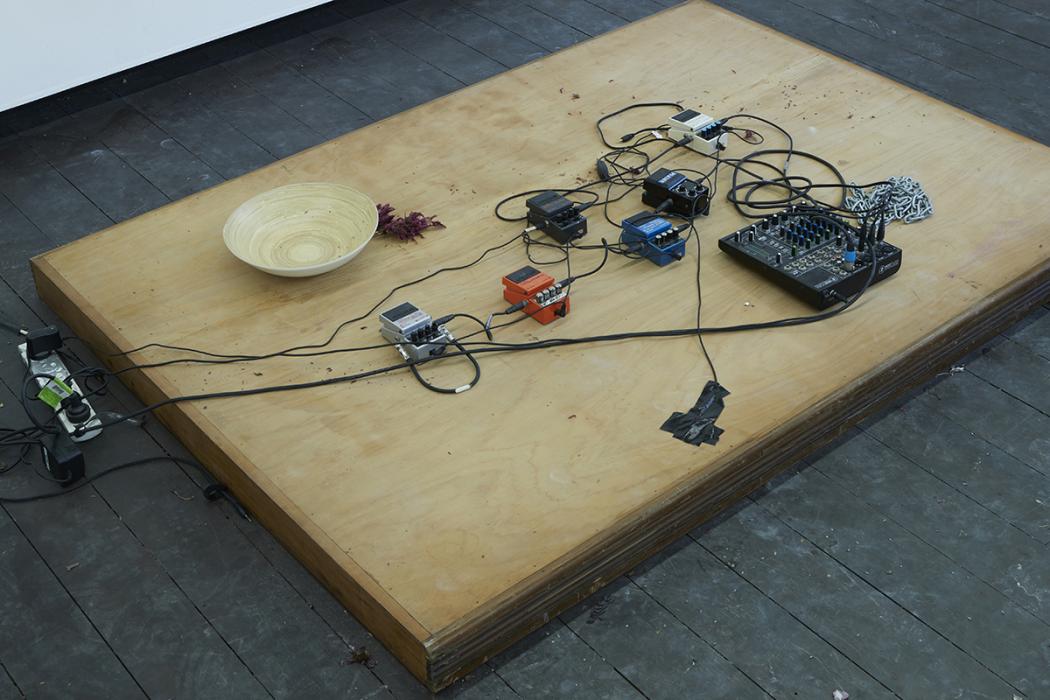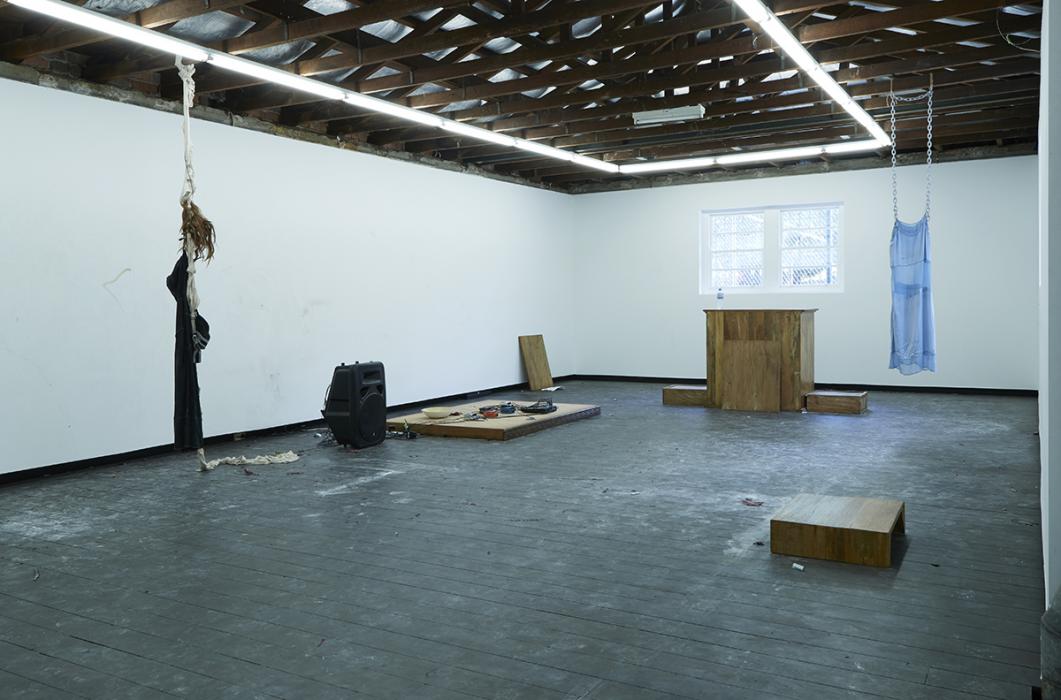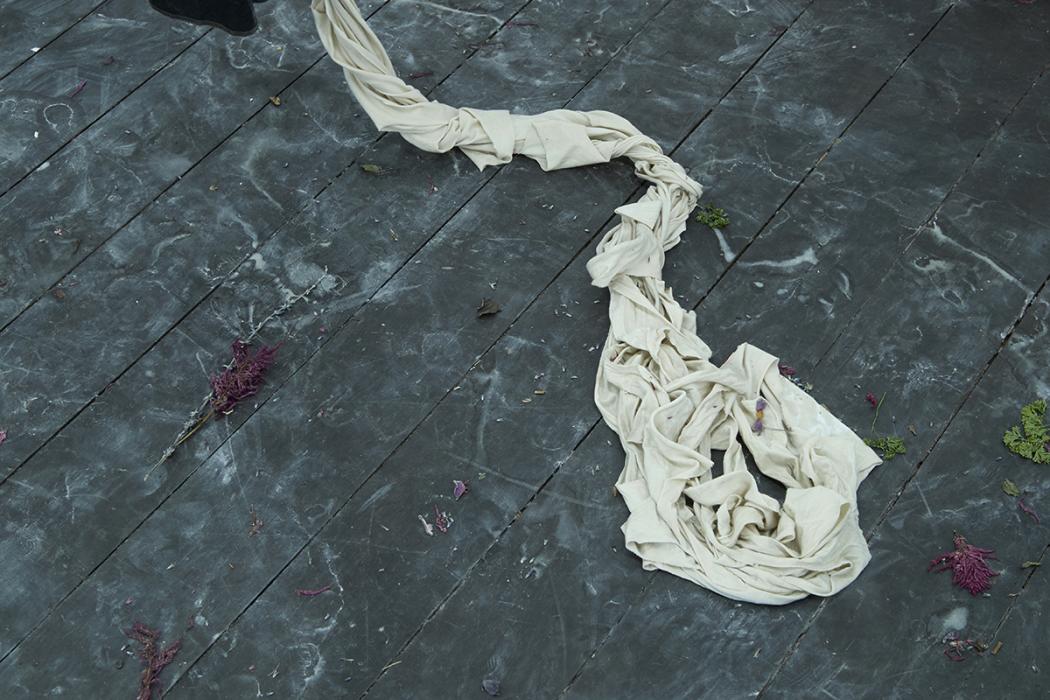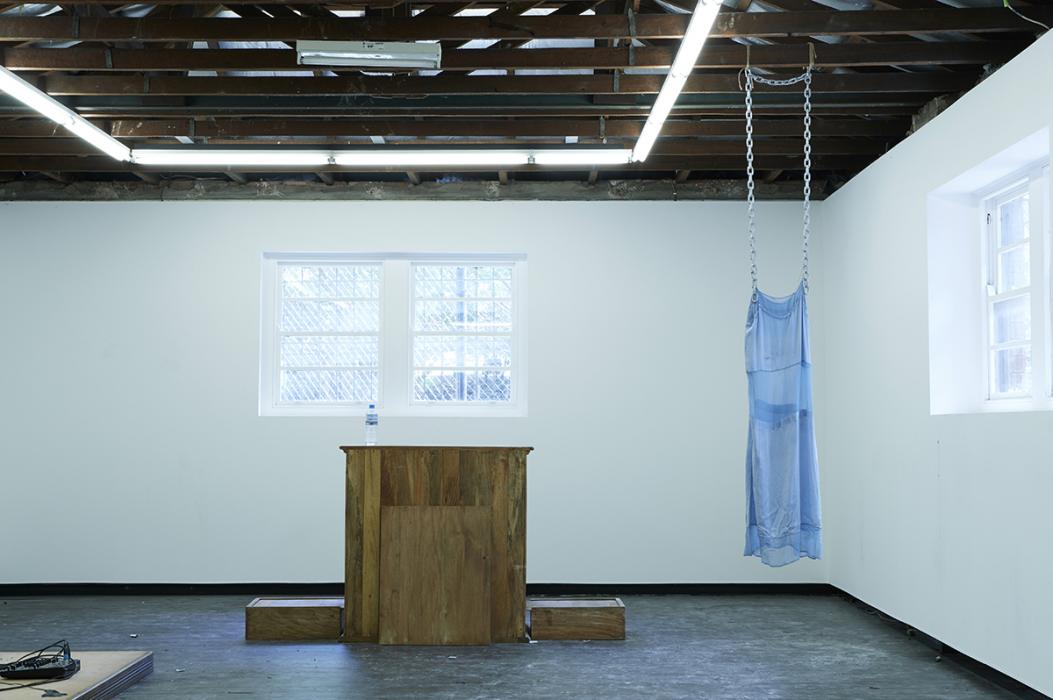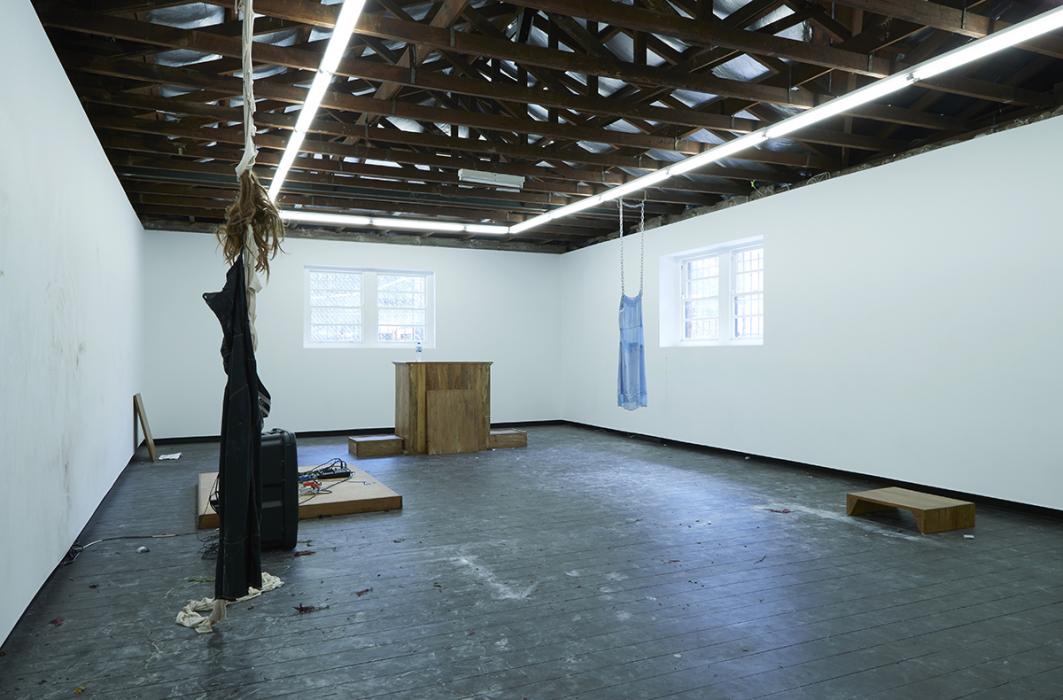Portrait/s of Embittered Swish
Forming in Melbourne in 2015 the performance art vessel, Embittered Swish, most recently presented Our Lady of the Flowers: Refracted, an exhibition and performance project at Firstdraft (Sydney). This project elaborated on a previous stage show mounted by Embittered Swish in 2016 at La Mama Theatre (Melbourne) that took as its starting point Jean Genet’s novel, Our Lady of the Flowers (1943). The Sydney iteration was a more abstract exploration of this text and a departure from the theatrical form. In the gallery space were positioned various wooden platforms, one of which was a low platform that displayed a mixer and distortion pedals entwined with metal chains. Down the far end of the gallery one of these platforms, centrally positioned, took the shape and solemnity of an altar. Slips and wigs were suspended from the rafters. A mechanised sculpture draped in lace, circled a mannequin’s hand. The floor, marked and strewn with flowers, retained the traces of performances that had taken place earlier in the gallery. Attending Our Lady of the Flowers: Refracted one Saturday afternoon, I witnessed a series of compelling performances including a movement piece in the heavy Sydney rain, improvisatory amyl sniffing, sonic sorcery, and many desirous embraces between the performers.
Our Lady of the Flowers: Refracted was a site for radical performativity, queered collectivity, and processual experimentation. To elaborate on these ideas, I interviewed the six (current) artists informing Embittered Swish. This article pieces together extracts from these interviews.
Frances Barrett (FB): You've described Embittered Swish as a 'vessel', ‘performance art vehicle’ and a 'conversation'. Why choose to frame your collaborative practice in these terms?
Cinnamon Templeton (CT): I feel like the word ‘collective’ is so fraught and that maybe ‘vehicle’ or ‘vessel’ are more transparent. Incidentally, ‘vessel’ is the term that I substitute for what other people might call identity, or my own identity. It’s not my own trans. identity but I consider my womanhood as a vessel. It’s a term that I have gravitated towards, like it is something with moving parts and not all of them are equal.
FB: What interests you in working collectively as Embittered Swish? How does Embittered Swish enable or become a vehicle for your performance-based practice and politics?
Mick Klepner Roe (MKR): Our work is based upon our personal experiences as trans people, as different people. It allows our work to be richer in terms of content because there are more people whose lives are informing the work.
Krishna Istha (KI): It enables you to take the script and make it your own in a more refined way… working collaboratively means that we can make an entire show – as opposed to a writer who has just a script – we have something that has movement, sound, text and acting, and that is what we get working collaboratively, we have something more formed.
Bobuq Sayed (BS): There are a lot more checks and balances in a collaboration, which produces a better outcome.
Romy Fox (RF): Absolute freedom to explore the notions of the transgender experience without feeling that my identity or artistic concepts are being used to make cisgender individuals feel “with it” and good allies when it comes to gender and sexuality in 2017.
FB: How does Embittered Swish embrace and give space/visibility to points of difference of the queer and trans experience?
BS: I think this is a question that doesn’t have any answers or resolutions in the present moment because it’s something that’s still being negotiated actively. What has been useful for us is enabling and facilitating an influx of new members, allowing the collective to be iterated in different spaces with different arrangements of performers and ideas… and that influx of ideas is central to the viability of any future for Embittered Swish… As far as our points of difference, we are separated by so many things and even though we are disseminated as an ‘all trans performance vehicle’ it has been really illuminating working with Embittered Swish and realising how different our experiences of transness are because of the fact that we are binary or non-binary, white or people of colour, Class is also huge because, as far as developing performances, it’s not an economic reality that many people are able to abandon their lives and their jobs to work in a gallery or work on a show and give that commitment to producing new projects, which, the collective demands. These points of difference are a strength that will continue to mobilise us in the future.
Mossy Pebbles (MP): We have an obligation to check in with each other and have critical discourse around race and identity, and gender and identity. I think that approaching those conversations with respect, openness and patience is what we’ll endeavour to do… it is nice to hang out and roll around together and play in movement and sound, but we are not free of labels and politics even amongst our collective. Our bodies are politicised so we always have to make sure that we be clear with what we are doing and saying with our bodies.
FB: Could you describe Our Lady of The Flowers: Refracted at Firstdraft and your individual performances?
KI: We had this month-long space at Firstdraft, which we treated like a residency. We were in there everyday and people would come in expecting to see a gallery space with artworks and they would come in to see us making instead… yeah, a real mess! From the first performance night, everything accumulated in the space.
CT: The structure of the Firstdraft show was literally a refraction or dispersion [of the staged performance of Our Lady of the Flowers at La Mama Theatre]. We did a performance on opening night where everyone was involved, but from then on we were working with collaborators we chose from Sydney. So all the [performances] were individual collaborations… I think the gallery show was actually an opening up, in a way that I found really gratifying. With the stage show we had more defined roles and we were working towards this theatre show, which has so many more rigid conventions and parameters than the art world does. Firstdraft was an opportunity for everyone to branch out. We weren’t working as a coherent group, we were all working individually but we had all started from the same point.
KI: What Bobuq and I made was about rituals, birth and death. And I can’t remember how this came about, but, we were talking about turmeric and how it is used to heal, its medicinal value, how it is used to clean new-born babies, etc. In the performance, Bobuq was meant to be someone that I loved and who I had lost and was cleansing [with turmeric]. I can’t actually remember what we did, to be honest! A lot of it was improvised – all we knew was that there was going to be turmeric and melodrama.
RF: It was tense. Working creatively in Sydney held a lot of interesting weight for me. I started out being driven by our stage show, but ended up responding to the ghosts of my past life living in Sydney. Both the traumatic and the beautiful.
MP: My performance was also very improvised… I really don’t know what it was but I thank the wet weather for the melodrama! I think that we do a lot of work behind the scenes that doesn’t necessarily get seen so, for example, one of the movements I did was in response to a piece of text that Bobuq had written. So I used this as an anchor point in that work. I also revisited things from Our Lady of the Flowers but then played with being possessed or hypnotised and presenting as bit of a sex object.
BS: I think with this iteration of Embittered Swish it became increasingly important to Krishna and I, as the only people of colour in the collective, to start redirecting the practice away from becoming negligent and dangerously apolitical in its reluctance to really confront race, racial othering and racial difference… What was really helpful working with Brian [Fuata, who we had invited to collaborate with us] was departing from a very introductory ‘Race 101’ that gets hung up on the politics of trauma, pity and sadness. I think in the art world, especially, that’s how people of colour are used to being historically inscribed, addressed, exhibited and spectacularised. So to work with Brian in a more spontaneous, humorous, meta- and philosophical performative dialogue was really beneficial for progressing my own practice of performing my race and bringing my race into the dialogue of the gallery space or theatre space... To actually infiltrate those fault lines of audience, performer, spectacle and stage, and to present brown bodies in a way that is humanising, intimate, wholesome and also sexy, is quite transgressive and radical, because the audience and the white gallery space and gaze have become so accustomed to the rituals of brown trauma, oppression and suffering.
FB: On the Saturday that I attended, I felt there was a recurring intention of arousal and antagonism towards the audience. This made me want to ask when developing a work and when performing it, how do you approach audience experience – who do you make work for?
BS: I think that dynamism between eroticism and nastiness or antagonism has been very useful for displaying trans bodies interacting. Because the reality is that we are terrorised and the terrorised treatment we receive is symptomatic of our bodies as terrorising and terrorised beyond our control. So flipping this script of who has agency over this process of terrorising and eroticising has a real political viability to it once you demonstrate your own agency over your body in space and how the audience is complicit in that.
CT: I think in terms of people approaching audience, everyone had very different ways of doing that… I think that arousal speaks to my personal practice. I feel like arousal has been quite powerful for me, and something to harness. And it’s like the sexualisation of trans women, the fetishisation, is something that has been quite present in my life and I think that in queer communities trans bodies are more symbolic, especially trans feminine bodies are more symbolic, of queerness rather than actual sites of eroticism – like podium dancers or something. So, I feel like engaging with arousal and trying to arouse an audience is one practice that I have found to be interesting or useful in terms of manipulating people’s expectations of my body.
RF: I always have other trans freaks in mind. Not to say that my work is exclusively for those who identity as trans – it's a window for everyone to peer into.
MP: I want the audience to leave horny and disturbed! [Laughter]
FB: The installation of Firstdraft involved the traces of everyone’s performances that ‘haunted’ the gallery space. Embittered Swish described these traces as ‘causing the ghosts of the immediate and more distant transgender past to resurface, confused’. This comment made me question whether Our Lady of the Flowers: Refracted generated what could be considered a trans time and space, as a divergence from a ‘queer’ time and space. What are your thoughts on this?
CT: I don’t know… I don’t want to put too many labels on the work. Personally queer time and space doesn’t speak to me heaps. I’m not sure what a trans time and space would look like. I think that our collective is diverse and more than something that has been consciously strategised, and that is a point that we are coming to now where we are thinking about more conscious strategies and how as a group we can collectively manipulate how our bodies are read. Embittered Swish has been a vehicle for play and experimentation and what intimacy might mean or what this moment might mean or what it might mean for these two people to participate in an action together.
We haven’t been talking explicitly about meaning-making or a theoretical framework. It really is as simple as we found this book [Jean Genet’s Our Lady of the Flowers], we found it evocative and we made work from it. There are pros and cons to that mode of working, but I would say that the primary mode has been one of experimentation. It has been interesting to me to watch the way that people have politicised it. I do think that it is political just like everything is, but I think it’s interesting that Embittered Swish has been the site of projections. And this is something that Bobuq has really started to raise this month, was the way we had just been floating along – I mean it has been difficult work, evocative in different ways – but we hadn’t been considering the issue of controlling the way that certain moments are read… I think we haven’t gotten to the point of labelling it. I think we use trans a lot, it is an all-trans thing, that’s never something that’s been a massive priority to me, to only work with trans people, because I also think it is a false separatism in the context of Embittered Swish because everyone comes from really different experiences.
MKR: I think that us making the work, even if we weren’t trying to, we would make it trans because we are. I think that is the first thing that is quite obvious… My self informs my work as anyone’s does. I think in the way that the space and the gallery was set up, yeah, I think that we were interested in presenting our bodies in the gallery space in a kind of provocative way and saying yep this is what you want. Like in the opening performance that we did, we were like here’s the sexualised trans body, here are the tropes that we can then play within, enjoy and also hate while we are doing them. But the question about time and ghosts and things… we wanted it to be messy and disrupt the stillness of the gallery because we are quite interested in change. So the fact that the gallery kept changing through the month—I guess that could be theorised as transness, if transness is about change, which, in my opinion, it is.
KI: I don’t know; I saw it as an archive. Trans people are often erased, you can’t find a lot of archiving material about trans artists. I saw our work as an archive, maybe it’s over a month but it’s still us saying we are here, we exist, and we’re archiving the space. And it’s gone, but it was there for that amount of time.
MP: Maybe there isn’t necessarily objects or debris in the room that you can read into as trans matter, but it has been produced and put there by trans bodies. We documented the process and it’s an important archive that we now have, and which we can polish up and put out into the world so that people can access it too.
RF: Trans time and space is definitely a different beast. A post-human journey through unexplored territory and medical experimentation. Queer time and space, while important, has drifted further into assimilating into the 'conventional'. Maybe it's because the traditional muses (transgender individuals) have the space to make work themselves and are no longer having their experiences filtered through the mouths and hands of queer storytellers.

